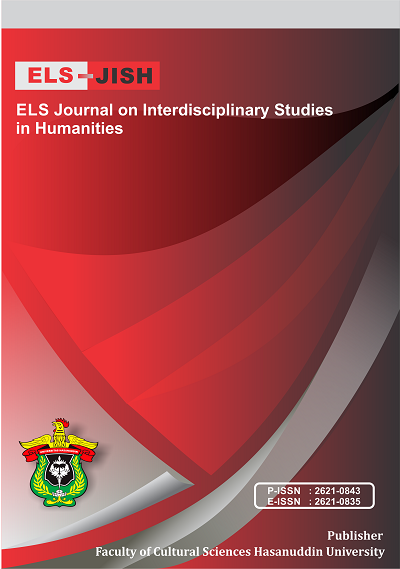Text Messaging in English and Arabic with Reference to Translation
DOI:
https://doi.org/10.34050/elsjish.v6i3.28121Keywords:
Text Messaging, Translation, Types of TextismsAbstract
In the twenty-first century, many people now live their lives through text messaging. In fact, you can witness people using their cell phones to send character-based messages to their friends, classmates, family members, and coworkers in malls, schools, and pretty much anywhere else. The popularity of this method of communication has increased particularly among young people. One benefit is that technology enables people to speak with others virtually anywhere. Second, it enables individuals to speak softly, which is useful in noisy places like bars, where it would be challenging to have a productive conversation over the phone, or when extraneous communication needs to be done quietly, such as in a school. Thirdly, it combines some of the advantages of phone and email communication by allowing them to communicate both synchronously (i.e., two-way communication occurs concurrently) and asynchronously (i.e., two-way communication is delayed). The usage of acronyms, abbreviations, and other shorthand notations has become commonplace in this technology's creation of a new language form. The focus of this research is on these qualities specifically and how they are used. The aim of this study was to analyze not only how frequently but also how these symbolic expressions are used in relation to the linguistic functions that they signal, which was followed by a number of discoveries.
References
Aziz, S., Shamim, M., Aziz, M. F., & Avais, P. (2013). The impact of texting/SMS language on academic writing of students-What do we need to panic about. Elixir Linguistics and Translation, 55(2013), 12884-12890.
Beasley, R. E. (2009). Short message service (SMS) texting symbols: A functional analysis of 10,000 cellular phone text messages. The Reading Matrix, 9(2).
Bell, R. (1991). Translation and Translating: Theory and Practice. London: Longman.
Crystal, D. (2001). Language and the Internet. Cambridge: CUP.
Farghal, M. & Shunnaq, T. A. (1999). Translation with Reference to English and Arabic: A Practical Guide. Jordan: Dar Al-Hilal for Translation.
Geertsema, S., Hyman, C., & Van Deventer, C. (2011). Short message service (SMS) language and written language skills: educators’ perspectives. South African Journal of Education, 31(4), 475-487.
Horbach, S. P., Schneider, J. W., & Sainte-Marie, M. (2022). Ungendered writing: Writing styles are unlikely to account for gender differences in funding rates in the natural and technical sciences. Journal of Informetrics, 16(4), 101332.
Hussain, Z., & Lukmana, I. (2019). An exploratory study to the characteristics of textisms in text messaging. In 3rd Asian Education Symposium (AES 2018) (pp. 469-472). Atlantis Press.
Iliyas, A. l. (1989). The Theories of Translation: Theoretical Issues and Practical Implications. Ministry of Higher Education and Scientific Research, University of Mosul, Iraq.
Latief, M. R. A., Khaerana, A. S. A., & Soraya, A. I. (2022). Translation Analysis: Syntactic, Semantic, and Pragmatic Strategies Used in Translating A Website of an Academic Institution. ELS Journal on Interdisciplinary Studies in Humanities, 5(3), 524-531.
Lin, A. M., & Tong, A. H. (2007). Text-messaging cultures of college girls in Hong Kong: SMS as resources for achieving intimacy and gift-exchange with multiple functions. Continuum, 21(2), 303-315.
Marchand, H. (1969). The Categories and Types of Present-Day English Word Formation. Alabama: University of Alabama Press.
Newmark, P. (1982). An Approach to Translation. Oxford, Pergamon Press.
Nishimura, Y. (2003). Linguistic innovations and interactional features of casual online communication in Japanese. Journal of Computer-Mediated Communication, 9(1), JCMC914.
Rahman, F., Abbas, A., Hasyim, M., Rahman, F., Abbas, A., & Hasyim, M. (2019). Facebook group as media of learning writing in ESP context: A case study at Hasanuddin University. Asian EFL Journal Research Articles, 26(6.1), 153-167.
Rahman, F. F., & Rahman, F. (2019). Translation or Intertextuality: A Literature Comparative Analysis of “The Young Dead Soldiers Do Not Speak” by Archibald MacLeish and “Krawang Bekasi” by Chairil Anwar. Elsya: Journal of English Language Studies, 1(3), 110-117.
Rangarajan, S., Ram, N. S., & Krishna, N. V. (2013). Securing SMS using cryptography. International Journal of Computer Science and Information Technologies, 4(2), 285-288.
Ricaforte, L. B. (2022). Social Media Exposure and Usage of Cyber Slang: Bases in Examining the Academic Writing Conventions of the Students. Shanti Journal, 1(1), 229-254.
Ronneberger-Sibold, E. (1990). Phonotactics and Prosodic Properties of ‘Short Words’ in German and French. Paper prepared for the 25th International Conference on Polish-English Contrastive Linguistics, Rydzyna, December 6-8, 1990.
Saxena, N., Shen, H., Komninos, N., Choo, K. K. R., & Chaudhari, N. S. (2018). BVPSMS: A batch verification protocol for end-to-end secure SMS for mobile users. IEEE Transactions on Dependable and secure Computing, 17(3), 550-565.
Sindoni, M. G. (2014). Spoken and written discourse in online interactions: A multimodal approach. Routledge.
Sobkowiak, W. (1991). Metaphonology of English Paronomasic Puns. Frankfurt an Main: Peter Lang.
Thurlow, C. (2003). Generation Txt? The Sociolinguistics of Young People’s Text Messaging. Discourse Analysis Online, 1(1). http://extra.shu.ac.uk/daol/articles.
Thurlow, C., & Brown, A. (2003). Generation Txt? The sociolinguistics of young people’s text-messaging. Discourse analysis online, 1(1), 30.
Downloads
Published
Issue
Section
License
Copyright (c) 2023 Ahmed Adel Nouri, Omar Ali Hussein

This work is licensed under a Creative Commons Attribution-ShareAlike 4.0 International License.






